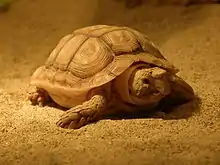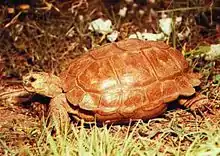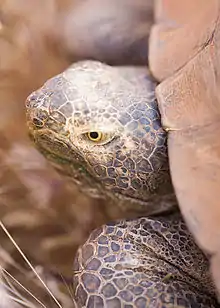Homopus
Homopus is a genus of tiny tortoises in the family Testudinidae, endemic to southern Africa. Three species have been moved to the genus Chersobius.
| Homopus | |
|---|---|
 | |
| Common padloper (Homopus areolatus) | |
| Scientific classification | |
| Kingdom: | Animalia |
| Phylum: | Chordata |
| Class: | Reptilia |
| Order: | Testudines |
| Suborder: | Cryptodira |
| Superfamily: | Testudinoidea |
| Family: | Testudinidae |
| Genus: | Homopus A.M.C. Duméril & Bibron, 1834[1] |
| Species | |
|
2 | |
Naming
As a group, these closely related species are commonly known in Europe and Africa as padlopers (originally meaning "path-walkers" in Afrikaans), due to their habit of making tiny pathways through vegetation.[2][3] In other parts of the world, such as the United States, they are known as Cape tortoises.[1][4]
Distribution
The genus is indigenous and endemic to South Africa.
Species
The genus contains these species:
| Image | Common Name | Scientific name | Distribution |
|---|---|---|---|
 | common padloper or parrot-beaked tortoise | Homopus areolatus | southern Cape coastal region, the most common padloper species.[5] |
 | greater padloper or Karoo cape tortoise [sic] | Homopus femoralis [6] | the highveld grasslands, the largest of the padlopers.[7] |
Conservation and captivity
They are threatened by habitat destruction,[4] traffic on roads, overgrazing, and poaching for the pet trade.[7] Another threat comes from introduced species, such as domestic dogs and pigs.
Among the Homopus species, H. areolatus adapts well to captivity, as their diets are not highly specialized.[3] The others do not generally survive well in captivity unless some effort is made to supply them with their natural food, that is, endemic plants from the Cape/Karoo regions.[3] Many are taken from their natural habitat each year, and subsequently die as a result, as they do not readily adapt to typical captive diets and environment change.[3] However, they can be very hardy in captivity, and most problems with captive care are caused by faulty nutrition, high humidity, or bad husbandry.[3]
References
| Wikimedia Commons has media related to Homopus. |
- ITIS (Integrated Taxonomic Information System). www.itis.gov.
- "Homopus Research Foundation, reports". Home.caiway.nl. Retrieved 2017-07-17.
- Corton, M., Homopus (Padloper Tortoise) Care, World Chelonian Trust (retrieved August 20, 2013).
- Obst, J.; Richter, K.; Jacob, U. (1988). The Completely Illustrated Atlas of Reptiles and Amphibians for the Terrarium. T.F.H. press.
- "Scarce Home". Academic.sun.ac.za. Retrieved 2017-07-17.
- Rhodin 2010, pp. 000.116
- "Homopus Research Foundation". Home.caiway.nl. Retrieved 2017-07-17.
